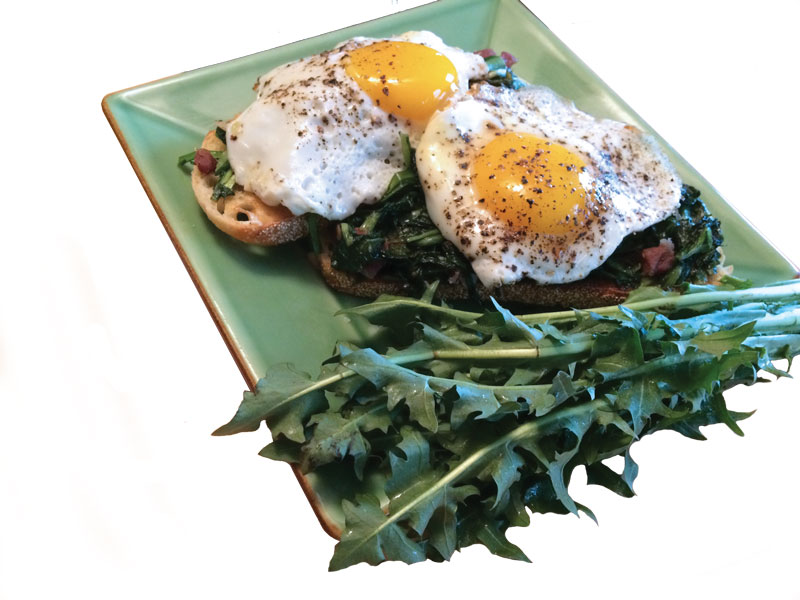I always find myself craving fresh spring greens as the weather warms. Something about the bracing bitterness of the greens awakens my palate and promises a cleansing after a long season of heavy foods. Dandelion greens are the most ubiquitous of these spring greens, emerging on our lawns almost as soon as the snow melts. Most of us opt not to harvest our own dandelions, even though the entire plant, from root to flower, is edible and chock full of incredible nutrition. In fact, we do our best to kill these “nuisance weeds” while opting to buy our bitter greens from the supermarket.
Foraging for your own dandelion greens is not only fun, but uber-nutritious when you consider that most produce purchased from a supermarket is about one week old, traveling from continents away and losing precious nutrients along the way. If you care to try harvesting your own, choose only those plants that have not been exposed to even errant wisps of herbicide or road treatments, seeking plants well away from the roadside and off of treated lawns. For the most tender and least bitter leaves, pick young plants. Once the plant buds the leaves become increasingly bitter. Also, harvest in early morning, giving the leaves a quick cold-water bath to freshen them up before serving.
As greens go, dandelions earn top grades for nutrition. They contain a whopping 525% percent of the daily-recommended amounts of vitamin K, thus making them one of the best plant sources for bone health. They also contain 112% of the recommended daily requirement of carotenoids, a precursor to vitamin A, important nutrients for skin and vision. Just one serving of dandelion greens provides 32% of the recommended daily amount of vitamin C. But that is not all. Dandelion greens contain many other important vitamins and minerals, as well as key flavonoids thought to aid in the prevention of disease such as cancer and Alzheimer’s. The plants have been used for centuries for their medicinal properties, including blood cleansing, liver detoxification, and gall bladder and kidney health. They are also thought to aid digestion, as the bitter components in the greens stimulate the release of digestive enzymes and beneficial bile.
If you just can’t bring yourself to forage for your own dandelions greens, by all means try them from the supermarket or farmers market. Choose greens that are bright and crisp, with thin, non-woody stems. Use them quickly as they tend to wilt and degrade within days.
Dandelion greens are wonderful served raw in salads, or steamed, sautéed, or braised. Their bitterness is wonderfully offset with bracing acidity (vinaigrettes) or rich fatty flavors (cream sauces, bacon fat). Young, fresh leaves make great salad greens, while older leaves are best for cooking. To temper some of their bitterness, try blanching the leaves for 20 seconds in boiling water, followed by a dip in ice water. Blanched greens are great mixed into grain salads, sautéed with plenty of fat, or added to casseroles, stews or soups. If you find the leaves are just too bitter for your palate, try mixing them in with other greens like kale, spinach or chard.
The following recipe works for several reasons. The richness of the egg yolk and the butter, along with the tartness of the Dijon, nicely cut the bitterness of the greens and make a delicious combination. If you wish to minimize the bitterness of the greens further, first blanch and pat them dry, then saute as directed.
Dandelion Green, Bacon and Egg Breakfast Bruschetta
Serves 2
INGREDIENTS:
- 2-3 slices bacon, chopped into small pieces
- 2 large eggs, preferably organic pastured
- 6 cups dandelion greens, bottom third of stem removed, leaves roughly chopped
- 1 large clove garlic, minced
- 2 sourdough bread slices
- 1 tablespoon softened butter
- 1/4 teaspoon Dijon mustard
- Salt and pepper to taste
- In a large skillet, cook bacon over medium heat until crisp. Remove with a slotted spoon and drain on a paper-towel lined plate. Return pan with reserved bacon fat to heat.
Reheat pan. Carefully crack and set down each egg, being gentle so as to prevent whites from spreading out too much. Sprinkle eggs with salt and pepper. Cook until whites are firm and cooked through but yolks are runny. Transfer eggs to a plate. - Return pan to heat. Add mustard greens, garlic and bacon. Cook, stirring frequently, until greens are wilted and tender, about 5 minutes, adding small amounts of water or oil if greens seem dry or start to stick. Season to taste with salt and pepper.
- Meanwhile, mix butter and Dijon mustard. Spread evenly across tops of each piece of sourdough. Toast until lightly golden brown and crispy. Place half of greens on each piece of bread and top with fried egg. Serve immediately.
Julie Wern is a psychologist turned stay-at-home-mom turned caterer. She is currently in training at the Institute of Integrative Nutrition to become a Nutrition and Wellness coach. She is the author of Holcomb Farm CSA’s Simply Fresh blog (http://holcombfarm.org/blog) and currently teaches cooking and cookie decorating classes. Contact Julie at jwern@comcast.net for comments and inquiries.
